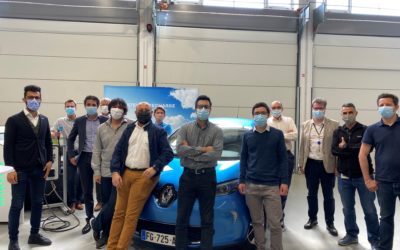French-German-Luxembourgish cross-border test bed inauguration: VEDECOM presents the TRIICA project
The inauguration of the trinational digital test bed took place on Wednesday, April 3rd 2019, in Schengen (Luxembourg). On this occasion, VEDECOM presented the TRIICA project, whose main goal is to demonstrate the continuous compatibility for communicating vehicles with driving delegation between three countries in relationship with the infrastructures.
The event took place in the presence of the ministers of Transport of France, Germany and Luxembourg, as well as the Luxembourgish deputy prime minister and the minister of Transport of the Saarland. The creation of the site reflects the common will of the three countries to promote the development and experimentation of various technologies for automated and connected driving in a real-world and cross-border context.
Coordinated by VEDECOM, the TRIICA project is seeking its European partners
Philippe Watteau, CEO of the VEDECOM Institute, took the opportunity of the event to present the TRIICA project (Test and Research on Intelligent Infrastructure for Collaborative Autonomous driving) which was set up by VEDECOM in response to the Call for Expression of Interest published by the Ministries of the three countries in 2018. The project is coordinated by VEDECOM and carried by a consortium of 6 French partners (Cerema, Sanef, YoGoKo as well as the French subsidiaries of 3M and Continental). They aim to further extend the consortium to German and Luxembourgish partners.
TRIICA project’s main goal is to demonstrate the continuous compatibility for communicating vehicles with driving delegation between three countries while valorising the benefits of road infrastructures for the development of automated driving technologies.
Analysing and comparing risk situations for autonomous vehicles in cross-border regions
The first step will consist of detecting and analysing for each country different specific road signalling types, leveraging vehicles with perception capabilities that are representative of level 4 connected autonomous vehicles. This comparison will allow to identify risk situations generated by specificities of cross-border context. Horizontal and vertical innovative road signalling will be tested to assess their potential additional value for autonomous driving vehicle. Continuity of the connectivity management (roaming) in cross-border regions will also be considered. To conclude this first use case, specifications and recommendations will be issued to guide the development of vehicles with driving delegation and their infrastructures.
An enriched Local Dynamic Map (LMD)
The second step will aim to widen the AD vehicles’ perception by eHorizon which is a cloud service enriched by a local dynamic map (LDM) giving the opportunity to inform the vehicle of risk situations leading to a decrease of the current SAE level. The capacity of the vehicle to initiate a fall back safe-stop manoeuvre in an informed refuge zone will therefore be considered.
Designing a new autonomous vehicle prototype to demonstrate the pre-determined concepts
In a last step, a new prototype vehicle with driving delegation, designed by VEDECOM, will integrate specifications developed in previous use cases. This will allow to demonstrate the various driving situations considered in the first steps.
As the project coordinator of TRIICA, VEDECOM will be leading the different research and development activities as well as the experimentations and evaluation.
Articles récents :
European 5G-MOBIX Project French site Demonstration and Seminar
5G for connected and automated cooperative mobility: towards greater safety and efficiency 21 April 2022, 9 AM - 6 PM Organisation : VEDECOM, Catapult, AKKA Technologies and VALEO Location: VEDECOM headquarters at mobiLab and Satory tracks, Versailles. 23 bis allée...
E-mobility: a successfull demonstration of the Certificate Trust List for Plug & Charge interoperability
The Certificate Trust List has been demonstrated on the 2nd of June 2021 as a technical solution for ISO 15118 Plug and Charge interoperability. The objective is to simplify the user experience wherever he is and guarantee the interoperability between any vehicle and...
“Machine Learning for the distributed and dynamic management of a fleet of autonomous taxis and shuttles”
Thesis defence of Tatiana BABICHEVA « Machine Learning for the distributed and dynamic management of a fleet of autonomous taxis and shuttles » 10 mars 2021 - 9h30 Online : Zoom Follow this event : [button...



